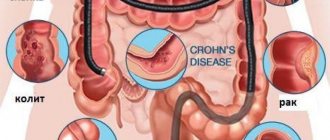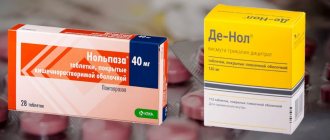Adenocarcinoma is one of the most common malignant tumors of the stomach, the danger of which is that for a long time the patient may have absolutely no idea about his condition. During the latent course of the disease, precious time is spent when it is possible to provide the patient with effective assistance and obtain a high result of treatment. Therefore, it is so important to know the characteristic signs of pathology that may signal impending serious health problems.
- 6 Treatment methods and admissibility of using folk remedies
- 7 Possible complications, prognosis and survival of patients with pathology
- 8 Disease prevention
- 9 Elena Malysheva about stomach cancer - video
What is gastric adenocarcinoma?
Adenocarcinoma is a malignant neoplasm that grows from the tissues of the glandular epithelium, which forms the gastric mucosa.
This type of cancer ranks fourth among all cancer pathologies and first among stomach cancers.
The insidiousness of this disease lies in the absence of symptoms in the early stages of tumor development, which significantly complicates the timely detection of cancer. Approximately half of patients turn to an oncologist with tumors in advanced stages, when radical intervention is no longer possible for a number of reasons.
With such a localization of the tumor, the patient has no idea about his condition for some time.
Classification
According to histopathological qualifications, the following forms of the disease are distinguished:
- well-differentiated gastric adenocarcinoma;
- moderately differentiated;
- poorly differentiated adenocarcinoma of the stomach.
The disease is also classified according to the type of tumor:
- ulcer-cancer - the tumor has the shape of a saucer with an ulcer in the center;
- scirrhus - the development of the tumor occurs strictly in the center and has a depression;
- polyploid - a formation with clear edges that resembles a polyp in shape;
- tubular - a tumor of cuboidal epithelial cells;
- mucous - a formation that arose from mucus-producing cells.
In addition, according to the degree of development, four stages of the disease are distinguished. The most favorable prognosis is given at stages 1–2. If a patient is diagnosed with the fourth stage of glandular gastric cancer, only maintenance therapy is carried out.
Reasons for the development of the disease
As with any other malignant neoplasms, oncologists do not have accurate data about the causes of gastric adenocarcinoma. It is believed that the following factors may provoke the development of pathology:
- chronic gastritis;
- adenomatous polyposis of the gastric mucosa;
- gastric ulcer caused by the bacterium Helicobacter pylori;
- dysplasia of the gastric mucosa;
- poor nutrition;
- alcohol abuse;
- genetic predisposition;
- long-term exposure to carcinogenic substances on the body.
Medical statistics show that in developed countries, in particular in Germany, where the majority of the population eats rationally, the incidence rate has noticeably decreased over the past few decades, while in countries with a low standard of living, on the contrary, it is growing.
Gastric ulcer increases the chances of developing adenocarcinoma
In addition, the trigger for malignancy (malignancy) of the mucous membrane can be a passion for diets low in dietary fiber, antioxidant substances and vitamins.
Most often, gastric adenocarcinoma is registered in older patients - after 50–60 years, and males are affected 3 times more often than women.
It should be remembered that malignant neoplasms do not affect a healthy stomach. In the vast majority of cases, their occurrence was preceded by certain pathologies of the organ, which can be considered as precancerous conditions.
Which doctor should I contact?
If you experience loss of appetite, digestive disorders, or pain in the stomach, you should consult a gastroenterologist. To identify adenocarcinoma, the doctor will prescribe an FGDS, radiography with contrast, ultrasound, CT and the necessary laboratory tests. Once the diagnosis is confirmed, treatment by an oncologist will be required.
Gastric adenocarcinoma is a common and insidious oncological disease, which in most cases is diagnosed already at stages III-IV. To detect such a tumor in a timely manner, it is necessary to consult a doctor when its very first signs appear - loss of appetite and dyspeptic disorders. Treatment tactics for adenocarcinoma are determined by the stage of the tumor process, location and histological appearance of the tumor.
- Can treating liver cancer with folk remedies help?
- Stomach cancer treatment, modern methods of treating stomach cancer
- All about treating diseases!: Treatment of stomach cancer with hemlock
- Stomach cancer treatment with folk remedies
How does pathology manifest itself in the early stages and during tumor disintegration?
At the initial stages of development, adenocarcinoma can masquerade as chronic gastric diseases - gastritis, peptic ulcers, etc., manifesting itself as sensations of heaviness and discomfort in the epigastric region, usually not associated with food intake.
As the disease progresses, the following symptoms appear:
- alternating constipation and diarrhea;
- fast fatiguability;
- decreased appetite;
- nausea, vomiting;
- anemia;
- severe or moderate pain in the epigastric region (above the navel);
- weight loss.
Pain in the epigastric region is one of the symptoms of gastric adenocarcinoma
The symptomatic picture depends on the location and form of adenocarcinoma. In other words, as soon as the tumor begins to interfere with the normal digestive process, local symptoms occur. For example, a tumor located in the antral segment of the stomach (at its exit) begins to interfere with the evacuation of gastric contents and thereby reveals itself. A neoplasm in the cardiac segment of the stomach (at the inlet) makes it difficult to swallow and move food into the stomach. If adenocarcinoma forms in places where it can remain undetected for a long time, there are practically no symptoms indicating problems in the gastrointestinal tract, which makes timely diagnosis difficult.
When the tumor reaches a large size, it can disintegrate, which threatens to perforate the gastric wall with subsequent effusion of the contents into the abdominal cavity. The resulting peritonitis can be fatal. The beginning of the disintegration of the tumor manifests itself with the following symptoms:
- vomiting contents resembling coffee grounds;
- internal bleeding, causing weakening of cardiovascular activity - drop in blood pressure, tachycardia;
- weakness, fainting, convulsions;
- pale skin;
- increase in body temperature.
How to lose 10 kg in a month: diet reviews
The answer to the question: “How to lose 10 kg in a month?” Depends a lot on where you're starting from. A slender girl weighing 60 kg is unlikely to weigh 50, even if she spends the whole month on chicken breasts and cucumbers, periodically drinking green tea.
But someone weighing about 110 kg can easily achieve such results by simply eliminating foods that retain excess fluid from their diet and adding fiber and protein. Another question is whether such a rate of weight loss is healthy - especially if all this is done purely at home.
There are two opposing points of view on this.
How much weight can you lose in 1 month: diets, menus, etc. First the official version. Sources recommended by WHO believe that losing 10 kg in a month is unsafe for health. They suggest losing around 500g per week, which will result in a loss of 2kg per month. And 10 - in 5 months. This slow pace allows you to achieve several goals:
- reduce stress levels. Diets often fail because cortisol levels increase. A person feels swollen and tired, and also hungry. This leads him not to slimness and health, but to completely opposite things. Because to keep your appetite in check, you need to control your stress levels. And this is achievable only with a soft diet;
- maintain the necessary muscle mass. A woman after 35 years loses 500 g of muscle every year for natural reasons. If we add to them the adherence to an unbalanced diet deficient in protein, we get the effect of slowing down metabolism and reverse “restructuring the body.” With each attempt to lose weight, your muscles will become less and less. The body's need for energy will decrease. And appetite, usually, does not follow it. As a result, six months after the diet, those losing weight acquire new fat cells. It is enough to repeat this several times and you will find out why things can fit completely differently at the same weight, and how sometimes you have to change your wardrobe, even though the scales show stable numbers;
- Such rapid weight loss can cause exacerbation of chronic diseases. Still, the disposal of fat deposits creates additional stress on the kidneys, liver, gastrointestinal tract and cardiovascular system. Therefore, the method is not recommended for people with health problems;
- Losing weight quickly comes with significant limitations. Technically, this result can only be achieved on a diet that provides a reduction at the level of “requirement minus 1000 kcal”, and excludes the intake of carbohydrates at any time, except for the pre-workout and post-workout window. This usually looks like 1 serving of oatmeal with egg whites, one apple with half a pack of cottage cheese and 2-4 micro portions of chicken breast with some greens. For a person far from “clean” nutrition, this is hell on earth. Such a diet causes a passion for excess food intake no less than objectively unbalanced diets from the Internet. As a result, after a month or two of following such a diet, it may happen that a person not only does not lose weight, but also gains it, because he will secretly overeat instead of a rationally organized exit from the diet;
- develop and consolidate healthy habits that will help maintain health and weight in the future. What does a typical unbalanced diet teach us? Just endure hunger, and nothing more. Well, at most, carry containers of food with you. What do we need in life to maintain weight? The ability to make the right choices in ordinary life situations. Here in front of you is a table set for a colleague’s birthday. It contains only sweet fruits, canapés and cheese slices. What will you choose? Will you have alcohol? Most women will take a canapé, sweet fruit and a glass of wine. Meanwhile, it would be more rational to wait for something hot, eat a piece of cheese, and drink mineral water. And if you have to go to a children's party with popcorn, cotton candy and some other fruit, what will you do? And if your child constantly asks for cupcakes, how will you bake them? With a glass of sugar and a glass of flour?
MORE ABOUT: Polyoxidonium how to dilute injections
Losing 10 kg in a month: alternative version
A number of fitness trainers refer to the fact that rapid weight loss is safe. They believe that it is enough just to remove junk food from the diet and add physical activity.
In particular, rapid weight loss with a 1400 kcal diet in most cases is advocated by the Americans D. Michaels and D. Warner.
And Bob Harper, popular in Russia, went even further - he wrote a book about a diet of 800-1000 kcal and losing weight by 10 kg in a month.
Fitness gurus refer to certain scientific studies that have proven that losing weight does not affect health in any way, it only improves it. But no one has studied how many people were able to maintain weight after such a rapid weight loss, and how many were not injured from back-breaking workouts. Therefore, the question of the appropriateness of such events must be decided individually.
How to lose 10 kg per month if you are overweight? If the doctor diagnoses obesity, he will also recommend a diet. It will be effective as it ensures a reduction in simple carbohydrates, unhealthy fats and other “empty” sources of calories.
Most nutritionists will advise doing the following:
- start drinking water. Calculate your need for it and drink 40 ml per 1 kg of body weight. Drink a glass of water immediately after waking up and half an hour before each meal;
- part with soda, sweet coffee cocktails and alcohol. These are not only “sugar” calories, but also an increase in appetite. Fast foods have become a successful business only because they drink their burgers with cola;
- adjust your diet. You may feel like you're not eating anything at all. You get up in the morning, drink a glass of tea with sugar, eat a couple of cookies or sweets. Come to work and go to the coffee machine for a glass of coffee and some chocolate. During lunch you usually finish your work and you don't have time. Maybe pour yourself some tea again. After lunch you run errands. By the evening, you almost lose consciousness from hunger, so if dinner is not ready, you start chewing whatever you can get your hands on. Week-old ice cream from the freezer? Please. Sausage and cheese sandwiches? Give me a couple! While you are preparing dinner, half of your daily calorie intake “leaks” into your body. And what's next? You start eating and don't want to anymore. But after a couple of hours, after doing household chores, you will definitely want it. So what, is it night outside? Well, of course, tea with sweets... Such a diet “pulls out” an average of 3000-4000 kcal per day. And their consumer never feels full;
- The routine should be like this: get up in the morning, have breakfast half an hour later. We counted down 3 hours and had a snack. After 2-3 hours - lunch. Then again after 3 hours, have a snack. In the evening, if it’s a training day, have a snack immediately after class, and later have dinner. A lot of food? Make no mistake, most people who are losing weight are given a portion with an energy value of about 200-300 kcal. You will always feel slightly hungry before your next meal. But the rest of the time - pleasant satiety;
- what to put on the plate? Newbies to losing weight are usually advised to learn how to cook healthy meals and follow the plate principle. Let's take a closer look.
MORE ABOUT: Prostate adenoma (enlarged prostate gland)
What is healthy food in the understanding of a nutritionist? This is food as simple as possible. You shouldn't, say, munch on a sausage with a bunch of ingredients for a dinner with macaroni, cheese and gravy with a bunch of other ingredients.
But you can eat simple food - a piece of boiled beef (no additives, a little salt and herbs), a tomato with a sprig of basil, and a portion of brown rice. No chemical dyes, additives or flavor enhancers. And you will be full.
A simple rule - if you cannot pronounce the name of the food ingredients, or the label is full of all sorts of “E”, preservatives, enhancers, do not buy it.
On a conventional dinner plate you need to put a vegetable salad so that it covers half the surface, and a “quarter” of meat dish and cereal side dish. Eat 3 of these a day, and snack on fresh fruit with sugar-free yogurt, and the weight will come off.
Diagnosis of a malignant tumor
First of all, a gastroenterologist or oncologist will perform a physical examination - listen to complaints, evaluate the patient’s appearance, the condition of external lymph nodes in areas of traditional adenocarcinoma metastasis.
The following examination methods will then be used to make an accurate diagnosis:
- laboratory blood tests, including tumor markers SA and CEA;
- esophagogastroduodenoscopy - examination using a fiber optic probe of the upper parts of the gastrointestinal tract - esophagus, stomach, pancreas, which allows not only to identify a tumor, but also to take tissue for a biopsy;
Esophagogastroduodenoscopy allows not only to identify a tumor, but also to take tissue for biopsy
- cytological examination of the selected material - determines the nature of cancer cells and the degree of their differentiation;
- X-ray of the stomach using a contrast agent - helps to accurately assess the location of the tumor and the defect of the gastric wall;
- endoscopic ultrasound - allows you to identify the condition of organs and internal lymph nodes located near the stomach;
- CT (computed tomography) and MRI (magnetic resonance imaging) - the main task of these diagnostic methods is not so much to detect a tumor, but to detect the presence of distant metastases in other organs and lymph nodes.
Magnetic resonance imaging helps to identify distant metastases in other organs and lymph nodes
Comprehensive diagnostics makes it possible to differentiate adenocarcinoma from gastric ulcers, gastritis, polyposis and other benign pathologies that have similar symptoms.
Treatment
If it is possible to correctly diagnose the disease in the initial stages, the patient is offered surgery to remove the tumor along with nearby altered tissues. In this case, more than 50% of the stomach and nearby lymph nodes are removed.
Surgical intervention in the final stages is not advisable. In this case, all vital organs affected by cancer will have to be removed along with the stomach.
In the final stages, the patient is prescribed supportive treatment:
- Radiation therapy;
- Painkillers;
- Chemotherapy sessions are prescribed simultaneously with radiation therapy.
Treatment methods and acceptability of using folk remedies
Treatment of gastric adenocarcinoma is carried out only with the help of surgery. Chemotherapy and radiation are not used as independent methods, but only as part of complex therapy.
Chemotherapy for the treatment of this oncological pathology is not very effective. It is usually used before surgery to reduce the size of the tumor. Radiation therapy is used to irradiate the surgical site after tumor removal to kill any tumor cells that may remain.
In cases where surgery is no longer possible in the later stages, radiation therapy and cytostatics are used as supportive (palliative) treatment.
Surgery is the main method of treating stomach tumors
Surgery can be performed:
- radically - by removing the entire stomach, part of the esophagus, intestines and regional lymph nodes;
- subtotal - with removal of the affected organ segment with a small area of adjacent tissue.
The choice of surgical option depends on the nature, size and location of the tumor, as well as its histological characteristics. In some cases, the traditional scalpel is replaced with a laser one, which allows the surgeon to perform more precise manipulations.
If for some reason the tumor cannot be completely removed, an endoluminal stenting operation is performed to restore the gastric lumen to ensure the patient is able to eat.
During the treatment period, the patient is recommended a gentle fortified diet, excluding alcohol, strong coffee, spicy, salty, fried and fatty foods, to reduce the load on the gastrointestinal tract. The diet should include foods containing plant fiber, fruit and vegetable juices . Food should be consumed in small portions 5-6 times a day.
Traditional medicine is not used to treat gastric adenocarcinoma! Moreover, they can harm the patient, who, by experimenting with infusions and decoctions, will miss valuable time for the treatment of pathology.
Lose 10 kg in a month at home
How to lose 10 kg in a month? This question often plagues the fair sex on the eve of spring or summer. It is very important to make the process smooth and not harm your health. The first results will motivate you to continue to maintain your diet and exercise. (High-tech available).
How to lose 10 kg in a month
1. Refusal of flour products. The online program for losing weight recommends not eating bread and its derivatives for some time.
2. Refusal of sugar and its derivatives. Even if you have a sweet tooth, you should limit yourself from foods that contain large amounts of sugar.
4. Rules for a light dinner and a hearty breakfast. Those who like to eat up at night gain weight much faster than those who refuse dinner altogether or replace it with protein foods.
5. Do not drink after eating. The rule familiar to us in childhood really does apply. By drinking this or that meal, we deliberately stretch the stomach. As a result, in the future we need to eat significantly more calories than usual. (Tanya Rybakova lost up to 3 kg in a week).
How to lose 10 kg in a month - real advice from Dr. Dukan.
This very strict diet will help you remove not only extra pounds from your body, but also toxins, and improve the condition of your skin, nails and hair. It was developed by a professional doctor and contains in its menu all the necessary elements for a balanced diet. You will not return to your old weight, and most importantly, it will work for absolutely everyone (even a 16-year-old girl).
Diet for extreme weight loss (menu for a month)
For those people who urgently need to lose a few kilograms, an extreme weight loss diet has been developed. You can stick to it exactly or replace it every day with similar products (pay attention to Protasov’s recipes).
1 week.1. For breakfast, you can eat your choice: low-fat yogurt, a handful of fruits or nuts. After 2 hours, if you feel hungry, you can snack on an apple. For lunch, you can prepare vegetable soup without frying and fat, low-fat fish or meat, and salad. Dinner - a glass of kefir.
Week 2. Breakfast – curd low-fat dairy products, a handful of raisins. Lunch – salad, fish or steamed meat, vegetables. Dinner – vegetable salad.
Week 3. Breakfast – whole grain bread, a handful of dried fruits. Lunch - 2 boiled eggs, 1 tablespoon of any cereal without oil. Dinner – cottage cheese and a glass of low-fat kefir.
Week 4. Breakfast – vegetable green salad with cola. Lunch – boiled chicken fillet and salad. Dinner – 2 baked apples.
It is worth considering the fact that you should not eat more than 300 grams at one meal.
It is also necessary to take into account a number of contraindications that are present in this diet.
Among them: • Pregnancy and breastfeeding • Acute period of chronic disease • Individuals over 55 years old • Children under 16
• Normal psycho – emotional upsurge.
Lose 10 kg in a month - exercises at home
In order for you to get quick results, you need to work on weight loss in a comprehensive manner. To do this, it is worth developing not only a nutritional system, but also intense training, in which the emphasis should be on cardio exercise.
Ideally, a trainer should select training and exercises, designing a program specifically for you, taking into account the individual characteristics of the body and the presence of chronic diseases.
You should start with a 15-minute workout. Every day increase the time to 45-60 minutes. As a warm-up, you can jump rope for 3-5 minutes.
• Run. How long should you run? In order to get rid of excess weight, it is recommended to start with running for 15 minutes. If you are a beginner, you can start by walking briskly on a treadmill or in a regular park. Over time, you need to increase the load and increase the pace. 30 minutes a day (morning or evening) is quite enough.
MORE ABOUT: Trichomoniasis: symptoms and treatment of trichomonas in women and men -
• Legs and buttocks. The most proven and best exercises are lunges and squats. But you should start with simple squats, which are the most energy-intensive and effective for the lower body.
• Abs and stomach. Such exercises as twisting, toad, boat are suitable. To do this, you need to lie on your back and lift your torso, tensing your abs. It is very important to control your neck muscles; it is better to focus your gaze on the ceiling. If you do everything correctly, you will feel a pleasant burning sensation in the abdomen.
Possible complications, prognosis and survival of patients with pathology
If treatment of the pathology is not started in a timely manner, the following complications may occur:
- perforation of the gastric wall;
- gastrointestinal obstruction;
- peritonitis;
- stomach bleeding;
- spread of metastases throughout the body.
Perforation of the gastric wall is a serious complication of advanced adenocarcinoma, which is fraught with the development of internal bleeding and peritonitis
The prognosis for gastric adenocarcinoma will depend on the location of the tumor, its degree of malignancy and the stage of the disease. Neoplasms of the upper and lower segments of the stomach, as already mentioned, manifest themselves earlier, when effective treatment is possible. Well-differentiated carcinomas have a better prognosis than poorly differentiated ones. Unfortunately, 80% of pathologies are diagnosed at relatively late stages, which significantly reduces the survival rate.
According to medical statistics, the five-year survival rate for this cancer pathology looks like this:
- Stage I - 80%;
- Stage II - 56%;
- III a stage - 38%;
- III b stage - 15%;
- Stage III - 9%;
- IV - does not exceed 5%.
Complications
The main complications of adenocarcinoma are associated either with an advanced pathological process or with treatment.
- If a tumor grows into the wall of the stomach and damages large blood vessels, a person will experience periodic or constant bleeding of varying intensity, from dripping to profuse (heavy).
- The presence of metastases in the liver, lungs and other organs disrupts their functioning and can lead to the development of failure (liver, pulmonary).
- The location of the tumor in the area of the pylorus leads to its stenosis.
- When the tumor compresses the blood vessels, venous circulation in the abdominal cavity is disrupted, which leads to ascites (fluid accumulation in the abdominal cavity).
The main complication of surgical treatment of cancer is bleeding from the gastric stump, the formation of pronounced scars in the area of the postoperative wound and disruption of the passage of food through the stomach. In some cases, it may be necessary to apply a gastrostomy, i.e., create a “bypass” for food.
If treatment of the organ was not started in a timely manner, then various complications may appear, namely:
- perforation of the stomach;
- bleeding;
- pyloric stenosis;
- ascites;
- anemia.
Gastric adenocarcinoma can be complicated by the following conditions:
- perforation of the stomach - the tumor grows into all layers of the organ and can cause their melting and perforation, in which the contents pour into the abdominal cavity and provoke the development of peritonitis;
- gastric bleeding – cancer cells cause damage to the walls of blood vessels and the development of bleeding;
- anemia - indigestion and frequent bleeding lead to a decrease in the level of hemoglobin in the blood;
- pyloric stenosis - the proliferation of tumor tissue can cause a narrowing of the pyloric lumen and lead to difficulty passing food from the stomach to the intestines;
- ascites – tumor tissue compresses the venous vessels and causes fluid accumulation in the abdominal cavity.











